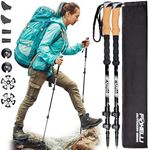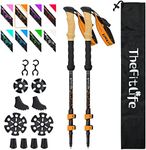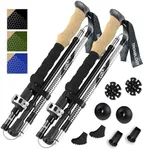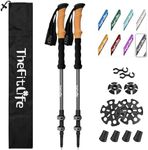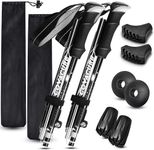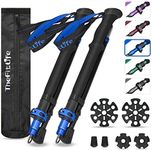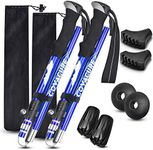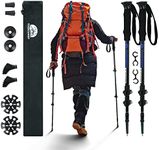Buying Guide for the Best Collapsible Hiking Poles
Choosing the right collapsible hiking poles can significantly enhance your hiking experience by providing stability, reducing strain on your joints, and improving your overall balance. When selecting hiking poles, it's important to consider various specifications to ensure they meet your needs and preferences. Here are some key specs to look at and how to navigate them.MaterialThe material of hiking poles affects their weight, durability, and cost. Common materials include aluminum and carbon fiber. Aluminum poles are generally more affordable and durable, making them suitable for rugged terrain and heavy use. Carbon fiber poles are lighter and can reduce fatigue during long hikes, but they may be more expensive and less durable in extreme conditions. Choose aluminum if you prioritize durability and cost, and carbon fiber if you prioritize weight and ease of use.
WeightThe weight of hiking poles is crucial for comfort and efficiency during hikes. Lighter poles are easier to carry and can reduce fatigue, especially on long treks. Heavier poles may offer more stability and durability but can be tiring to use over extended periods. If you plan on long-distance hiking or have concerns about fatigue, opt for lighter poles. For shorter hikes or more rugged terrain, heavier poles might be more suitable.
AdjustabilityAdjustable hiking poles allow you to change their length to suit different terrains and personal preferences. This feature is important for maintaining proper posture and balance. Poles with a wide range of adjustability can be used by multiple people and adapted to various hiking conditions. Look for poles with easy-to-use locking mechanisms and a good range of length adjustment. If you hike on varied terrain or share your poles, adjustable ones are a better choice.
GripThe grip of hiking poles affects comfort and control. Common grip materials include cork, foam, and rubber. Cork grips are comfortable, absorb sweat, and conform to your hand over time. Foam grips are lightweight and comfortable but may wear out faster. Rubber grips are durable and provide a firm hold but can be less comfortable over long periods. Choose cork for comfort and sweat absorption, foam for lightweight comfort, and rubber for durability.
Locking MechanismThe locking mechanism secures the pole at your desired length. Common types include lever locks and twist locks. Lever locks are quick and easy to adjust, making them convenient for changing pole length on the go. Twist locks are generally lighter but can be less reliable in wet or cold conditions. If you need quick adjustments and reliability, lever locks are preferable. Twist locks are suitable if you prioritize weight and don't need frequent adjustments.
TipThe tip of hiking poles provides traction and stability on various surfaces. Carbide tips are durable and provide good grip on rocky terrain, while rubber tips are quieter and better for softer surfaces like dirt or grass. Some poles come with interchangeable tips for different conditions. Choose carbide tips for rugged, rocky hikes and rubber tips for softer, quieter trails. Interchangeable tips offer versatility for different hiking environments.
PackabilityPackability refers to how compact the poles can be when collapsed. This is important for storage and transport, especially if you have limited space or need to carry them in a backpack. Look for poles that collapse to a small size and have a secure folding mechanism. If you need to pack your poles frequently or have limited storage space, prioritize packability. For less frequent packing, this may be less critical.
